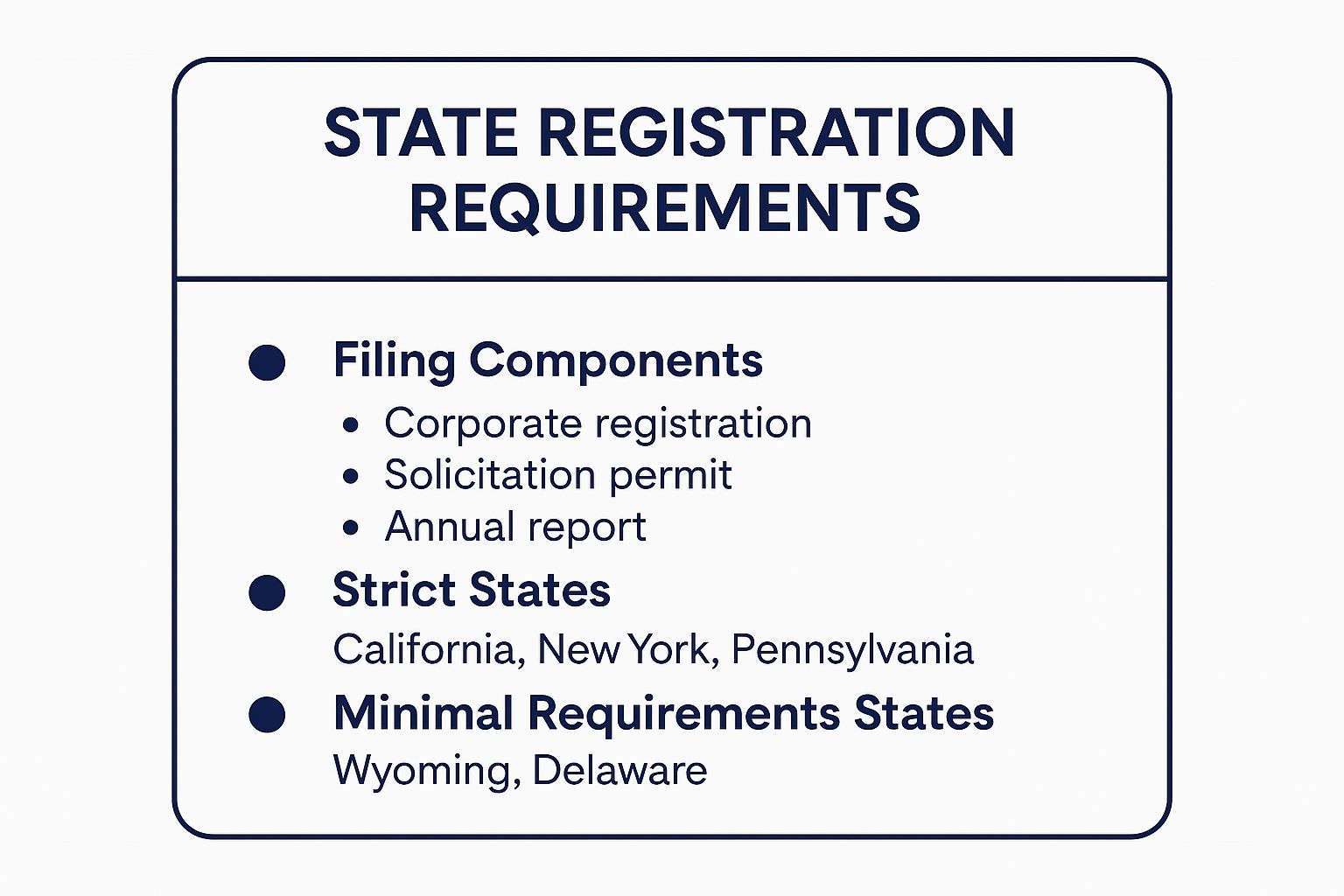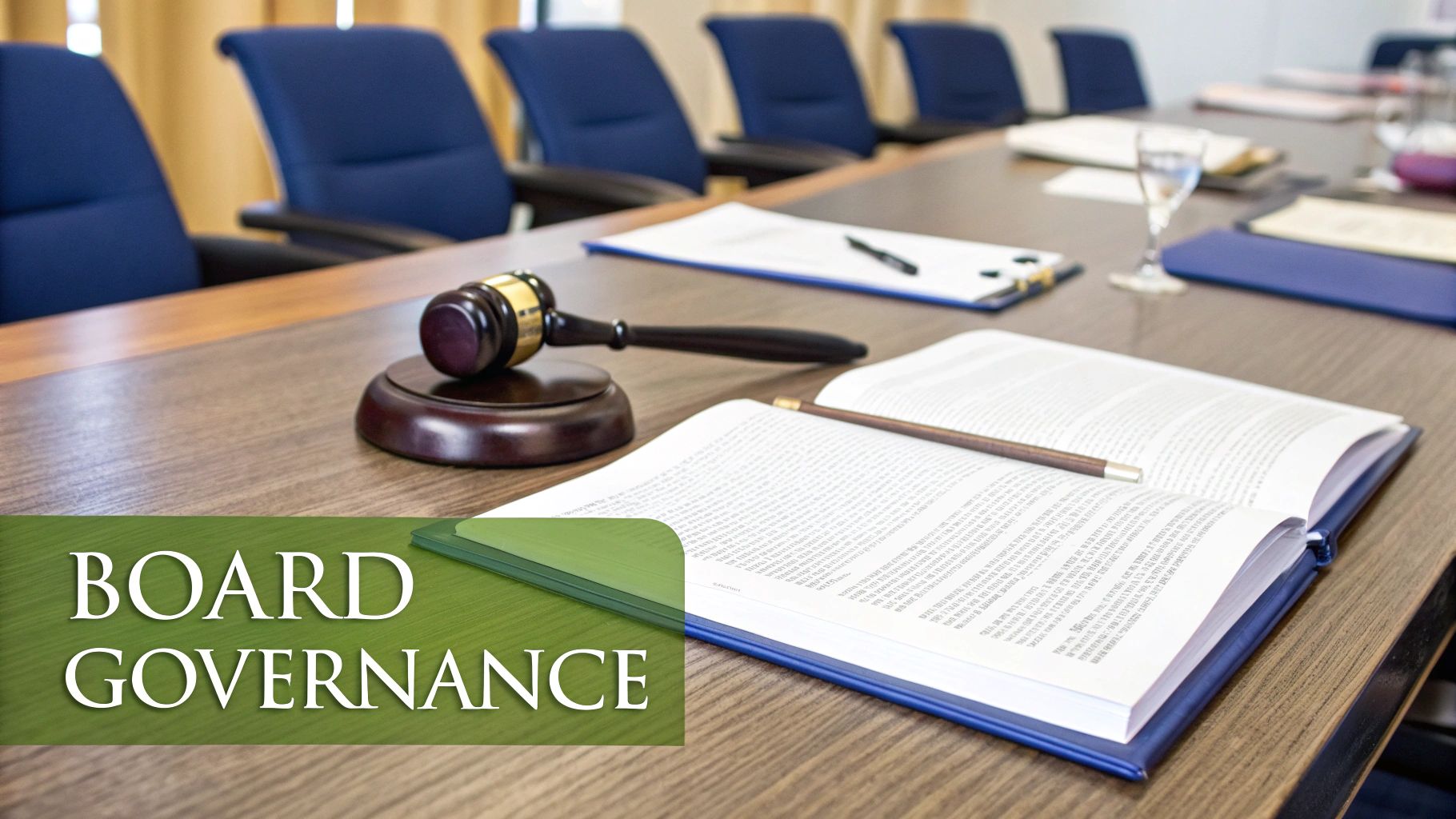
Operating a nonprofit organization is a mission of passion, but passion alone doesn't satisfy legal and regulatory requirements. From federal tax filings to state-level fundraising rules, the landscape of nonprofit compliance is complex and constantly evolving. Missteps can lead to significant penalties, loss of tax-exempt status, and damage to your public reputation. This is where a robust nonprofit compliance checklist becomes an indispensable tool. It transforms overwhelming obligations into a clear, actionable plan that protects your organization.
This guide provides a comprehensive checklist covering the seven critical pillars of compliance. We will break down everything from IRS filings and board governance to fundraising regulations and data privacy. Using a structured approach helps build a foundation of trust, transparency, and operational excellence, empowering you to focus on what truly matters: your mission.
To help jumpstart your efforts, consider using structured documents to track each item. You can explore available resources such as free checklist templates to create a customized system for your organization. Let's dive into the essential steps to ensure your nonprofit is not just doing good, but doing it right.
1. IRS Form 990 Annual Return Filing
The IRS Form 990 is arguably the most crucial annual filing for a tax-exempt organization and a cornerstone of any nonprofit compliance checklist. This public-facing information return provides a comprehensive overview of your organization's finances, governance structures, and program activities for the fiscal year. More than just a tax document, it's a transparency tool that allows the IRS, potential donors, grantmakers, and the general public to verify your adherence to tax-exempt status requirements and understand your mission's impact.

Filing the correct version is critical. Organizations with gross receipts of $200,000 or more, or total assets of $500,000 or more, must file the full Form 990. Smaller organizations may be eligible to file the shorter Form 990-EZ or the e-Postcard (Form 990-N), depending on their financial activity. Failing to file for three consecutive years results in the automatic revocation of your tax-exempt status, a devastating outcome that can halt operations.
How to Implement and Succeed
Successful and timely Form 990 filing is a year-round activity, not a last-minute scramble. It begins with meticulous record-keeping.
- Establish a System: From day one of your fiscal year, maintain detailed and organized financial records. Use accounting software to track all revenue sources (donations, grants, program fees) and expenditures.
- Engage Professional Help: Consider hiring a CPA or accounting firm specializing in nonprofit tax law. Their expertise is invaluable for navigating the form's complexities and ensuring accuracy, especially with required schedules for activities like lobbying or foreign operations.
- Gather Governance Information: The form requires details on board members, governance policies (like conflict of interest), and executive compensation. Keep meeting minutes and policy documents updated and accessible.
Actionable Tips for Filing
To streamline the process and avoid common pitfalls, follow these best practices:
- Review Previous Filings: Before starting the current year's return, carefully review your prior year's Form 990. This helps ensure consistency in how you report ongoing programs and financial data.
- Utilize IRS Resources: The IRS provides detailed instructions for each version of the Form 990, along with helpful guides like Publication 557, "Tax-Exempt Status for Your Organization."
- Tell Your Story: Use the narrative sections, like Part III (Statement of Program Service Accomplishments), to clearly and compellingly describe your achievements. This is your chance to frame the financial data with your mission's success.
2. State Registration and Reporting Requirements
Beyond federal IRS obligations, a critical piece of any nonprofit compliance checklist involves navigating a complex web of state-level rules. Nonprofits must register and remain in good standing with their state of incorporation and, crucially, in any state where they actively solicit donations or conduct significant program activities. This goes far beyond a one-time setup; it involves filing annual reports, maintaining a registered agent, and adhering to specific charitable solicitation laws that protect donors.
These requirements vary dramatically from one state to another. For example, California requires an annual registration renewal with the Attorney General's Office, while New York mandates the annual CHAR500 filing for most nonprofits. Failing to comply can lead to fines, penalties, and even a prohibition on fundraising in that state, severely limiting your organization's reach and financial stability. Diligent tracking of these varied deadlines and requirements is non-negotiable for multistate operations.
This infographic summarizes the core components of state-level compliance.

The visualization highlights how compliance involves multiple filing types and that regulatory burdens differ significantly, with states like New York being far more stringent than states like Wyoming.
How to Implement and Succeed
Proactive management is the key to successfully handling state compliance. This process begins with a thorough audit of your organization's activities to determine where you have registration obligations.
- Create a Compliance Calendar: Identify every state where you need to register. Create a master calendar that lists each state's specific filing requirements, report due dates, and associated fees.
- Appoint a Registered Agent: You must have a registered agent with a physical address in each state of registration. This agent is responsible for receiving official legal and state correspondence on your behalf.
- Understand Solicitation Laws: Research the "charitable solicitation" laws for each state where you fundraise. This includes online fundraising, as donations from residents of a particular state can trigger registration requirements there.
Actionable Tips for Filing
To avoid falling out of compliance and facing potential penalties, integrate these practices into your operational workflow.
- Use Centralized Resources: Leverage platforms like the Unified Registration Statement (URS) or consult resources from the National Association of State Charity Officials (NASCO) to streamline multistate filings.
- Keep Information Current: Promptly update your information with each state agency whenever there is a change in your address, leadership, or registered agent. Outdated information can lead to missed notices.
- Budget for Compliance: Factor in the costs of registration fees, registered agent services, and potential professional assistance into your annual budget. For a deeper dive, you can learn more about nonprofit reporting requirements.
3. Board Governance and Conflict of Interest Policies
Effective board governance is the bedrock of a healthy nonprofit and a critical element of any nonprofit compliance checklist. Strong governance involves establishing clear policies and procedures that guide the board of directors in their fiduciary duties of care, loyalty, and obedience. Central to this is a robust conflict of interest policy, which is essential for protecting the organization from transactions that could improperly benefit its leaders and jeopardize its tax-exempt status under IRS intermediate sanctions rules.

The IRS emphasizes governance heavily, particularly in the redesigned Form 990, which asks specific questions about the presence of a conflict of interest policy, independent board members, and procedures for determining executive compensation. Failing to manage these areas properly can lead to significant penalties, loss of public trust, and damage to the organization's reputation. For instance, many hospital systems maintain strict conflict policies for physician board members to ensure that decisions prioritize patient care and community benefit over personal financial interests.
How to Implement and Succeed
Successful governance isn't accidental; it's cultivated through intentional structure and consistent practices. The goal is to create a culture of transparency and accountability from the top down.
- Develop Core Policies: Work with legal counsel to draft and formally adopt key governance documents. This must include a conflict of interest policy, a whistleblower policy, and a document retention policy.
- Maintain Board Independence: Ensure a majority of your board members are independent, meaning they do not have financial relationships with the nonprofit outside of their board role. This is crucial for unbiased oversight.
- Document Everything: Keep meticulous minutes of all board and committee meetings. These records should detail major decisions, especially those related to compensation or transactions with interested parties, and document how any potential conflicts were managed.
Actionable Tips for Filing
To ensure your governance practices are compliant and effective, integrate these ongoing actions:
- Require Annual Disclosures: Have every board member and key employee sign a conflict of interest disclosure statement annually, attesting that they have read the policy and disclosing any potential conflicts.
- Provide Regular Training: Don't let your policies just sit on a shelf. Conduct regular training sessions for board members, especially new ones, to ensure they understand their legal responsibilities and the organization's governance procedures.
- Utilize Expert Resources: Organizations like BoardSource offer templates, guides, and workshops that provide a strong foundation for developing best-practice governance policies tailored to your nonprofit's size and mission.
4. Employment Law Compliance
Operating as a nonprofit does not exempt an organization from its responsibilities as an employer. Adhering to federal, state, and local employment laws is a critical component of any nonprofit compliance checklist. These regulations govern nearly every aspect of the employee lifecycle, from hiring and compensation to workplace safety and termination. This includes complex areas like wage and hour laws, anti-discrimination statutes (Title VII, ADEA, ADA), and benefit obligations.
Missteps in this area, such as misclassifying an employee as an independent contractor or failing to pay overtime, can lead to significant legal and financial penalties. For instance, a social service agency must be diligent in properly classifying its caseworkers and support staff versus its volunteers to avoid wage claims. While certain religious organizations may have specific exemptions, they must still follow most core employment laws. Staying current is key, as these laws are constantly evolving.
How to Implement and Succeed
Proactive management of human resources is the foundation of successful employment law compliance. This involves creating a structured, fair, and legally sound framework for managing your workforce.
- Develop a Comprehensive Employee Handbook: This document is your first line of defense. It should clearly outline policies on equal opportunity employment, anti-harassment, leave procedures, compensation, and standards of conduct. Have it reviewed by legal counsel.
- Establish Clear Worker Classifications: Understand the legal tests for classifying individuals as employees, independent contractors, or volunteers. Maintain detailed records and agreements that justify each classification to prevent costly misclassification disputes.
- Maintain Meticulous Personnel Records: Keep organized and confidential files for each employee containing their application, offer letter, performance reviews, compensation details, and any disciplinary actions. These records are vital for defending employment decisions.
Actionable Tips for Filing
To mitigate risks and foster a positive work environment, integrate these best practices into your HR operations:
- Provide Regular Training: Conduct mandatory training for all staff and board members on topics like preventing harassment and discrimination. This demonstrates a commitment to a safe workplace and can reduce liability.
- Consult Legal Counsel: For complex situations like terminations, disability accommodations, or responding to discrimination claims, always engage an attorney specializing in nonprofit employment law.
- Stay Informed: To ensure thoroughness in your compliance efforts, especially concerning your workforce, consulting a 2025 HR compliance checklist can be highly beneficial. This helps you stay updated on new regulations and requirements.
5. Financial Controls and Audit Requirements
Robust financial controls and transparent audit procedures are the bedrock of a nonprofit's credibility and a vital part of any nonprofit compliance checklist. These systems ensure that financial resources are managed responsibly, protected from fraud, and used to advance the organization's mission. Beyond internal governance, many states, federal agencies, and major funders mandate specific financial oversight, often requiring an annual audit or review conducted by an independent CPA.
Strong controls demonstrate accountability to donors, grantmakers, and the public, building trust and safeguarding the organization’s reputation. For instance, federal grant recipients must adhere to the strict Uniform Guidance audit requirements, while many foundations, like United Way, make an annual audit a prerequisite for funding. Neglecting these controls not only risks financial mismanagement but can also lead to the loss of critical funding and legal standing.
How to Implement and Succeed
Implementing effective financial controls is about creating a culture of accountability, not just checking boxes. It starts with formally documented policies and procedures approved by the board of directors.
- Establish a System: Create clear, written financial policies covering everything from expense reimbursement and check signing authority to cash handling and credit card usage. The cornerstone of this system is the segregation of duties, ensuring no single individual has control over an entire financial transaction.
- Utilize Proper Tools: Implement accounting software specifically designed for nonprofits. These tools can help track restricted funds, manage grant reporting, and generate the financial statements needed for board review and audit preparation.
- Conduct Regular Reviews: The board or a dedicated finance committee should review detailed financial reports (such as the statement of financial position and statement of activities) on a monthly or quarterly basis. This regular oversight helps identify potential issues before they escalate.
Actionable Tips for Filing
To maintain compliance and prepare for a seamless audit, focus on proactive and organized financial management throughout the year.
- Create an Audit-Ready Environment: Don't wait until year-end to gather documents. Maintain organized digital or physical files for bank statements, invoices, grant agreements, and major contracts as they come in.
- Develop a Financial Policies Manual: A comprehensive manual serves as a guide for staff and a key document for auditors. It should clearly outline procedures for approvals, record-keeping, and internal controls.
- Communicate with Your Auditor: Engage an independent CPA firm early. Discuss their timeline and requirements, and ask for a "prepared by client" (PBC) list well in advance to ensure you have everything ready. This proactive communication can significantly reduce audit-related stress and costs. Learn more about effective nonprofit financial management strategies to strengthen your organization's practices.
6. Fundraising and Donor Privacy Compliance
Effective fundraising is the lifeblood of most nonprofits, but it comes with significant legal responsibilities. Adhering to fundraising and donor privacy regulations is a critical component of any nonprofit compliance checklist, ensuring that your solicitation activities are lawful, ethical, and build trust with your supporters. This area of compliance involves navigating a complex web of state and federal laws that govern how you ask for money, what you must disclose, and how you protect donor information.
These regulations are multifaceted. Most states require nonprofits to register before soliciting donations from their residents, a process that often needs annual renewal. Federal laws like the CAN-SPAM Act for email and the Telephone Consumer Protection Act (TCPA) for calls and texts impose strict rules on communication. Furthermore, maintaining donor confidentiality and providing timely, accurate gift acknowledgments are not just best practices; they are foundational to maintaining your organization's integrity and your donors' confidence.
How to Implement and Succeed
Proactive management of fundraising compliance protects your organization from fines, penalties, and reputational damage. Success hinges on integrating compliance checks directly into your fundraising strategy.
- Map Your Solicitation Footprint: Identify every state where you actively solicit donations, including through your website, email campaigns, or social media. This determines where you need to register.
- Develop Clear Policies: Create and implement internal policies for donor privacy, data security, and communication consent. Ensure all staff and volunteers involved in fundraising are trained on these protocols.
- Systematize Acknowledgments: Use donor management software to automate and track gift acknowledgments. Ensure these receipts contain the required IRS language for tax-deductibility.
Actionable Tips for Filing
To maintain compliance and foster strong donor relationships, embed these practices into your operations:
- Leverage Unified Registration: For multi-state fundraising, use the Unified Registration Statement (URS) where accepted. This single form can streamline registration in multiple states, saving significant time and effort.
- Provide Clear Opt-Outs: Every fundraising communication, whether digital or print, must include a clear and easy way for recipients to opt out of future messages. Honor these requests promptly.
- Maintain Detailed Records: Keep meticulous records of all solicitation activities, state registrations, and donor communications. This documentation is essential proof of your compliance efforts if questions ever arise.
7. Data Protection and Privacy Compliance
In today's digital world, protecting sensitive data is a non-negotiable part of any comprehensive nonprofit compliance checklist. Nonprofits handle a vast amount of confidential information, including donor financial details, client personal records, and employee data. Failing to safeguard this information not only risks reputational damage and loss of trust but can also lead to severe legal and financial penalties under various data privacy laws. Strong data protection is a critical operational responsibility that demonstrates integrity to your stakeholders.

The specific regulations your nonprofit must follow depend on your activities, location, and the people you serve. For instance, healthcare-focused nonprofits must comply with the Health Insurance Portability and Accountability Act (HIPAA), while educational institutions are bound by the Family Educational Rights and Privacy Act (FERPA). Organizations with international donors or operations may need to adhere to the General Data Protection Regulation (GDPR). Understanding which laws apply to you is the first step toward compliance. A key component of this is developing a robust privacy policy that clearly outlines how your organization collects, uses, and protects personal information.
How to Implement and Succeed
Effective data privacy goes beyond having secure passwords; it requires a proactive, organization-wide strategy. This approach is a core element of effective nonprofit risk management.
- Conduct a Data Audit: First, identify all the sensitive data your organization collects and stores. Understand where it is located, who has access to it, and how it is protected.
- Establish Clear Policies: Create and enforce internal policies for data handling, retention, and destruction. This includes guidelines for remote work and the use of personal devices.
- Invest in Cybersecurity Training: Regularly train all staff and volunteers on privacy best practices, how to recognize phishing scams, and their responsibilities in protecting data.
Actionable Tips for Filing
To build a resilient data protection framework and ensure ongoing compliance, focus on these practical steps:
- Implement Strong Technical Safeguards: Use multi-factor authentication (MFA) on all systems, encrypt sensitive data both in transit and at rest, and maintain up-to-date antivirus software.
- Develop a Breach Response Plan: Don't wait for a crisis to happen. Create and regularly test a data breach response plan so your team knows exactly what steps to take if an incident occurs.
- Perform Regular Security Assessments: Periodically conduct vulnerability testing and security audits to identify and address weaknesses in your systems before they can be exploited.
Nonprofit Compliance Checklist Comparison
From Checklist to Culture: Embedding Compliance in Your Mission
Navigating the landscape of nonprofit compliance can feel like an exhaustive, never-ending task. From the detailed intricacies of your annual IRS Form 990 filing to the meticulous management of donor data, the responsibilities are significant. The comprehensive nonprofit compliance checklist we’ve outlined serves as a vital roadmap, ensuring you address critical areas like state registration, board governance, employment law, and financial controls. But checking these boxes, while essential, is only the starting point. The ultimate goal is to evolve beyond reactive compliance and foster a proactive culture where these practices are deeply embedded into your organization's daily operations and strategic vision.
Think of it this way: a checklist is a tool, but a culture of compliance is a mindset. It’s the difference between annually reviewing your conflict of interest policy and actively ensuring board members understand and disclose potential conflicts in every decision they make. It’s the difference between simply having a privacy policy and training every staff member on how to handle sensitive information with the utmost care. This cultural shift transforms compliance from a burdensome obligation into a strategic asset. When transparency, accountability, and ethical conduct become second nature, you build a foundation of trust that is invaluable. This trust resonates with donors, strengthens partnerships with foundations, and deepens your connection with the community you serve.
Key Takeaways for Lasting Compliance
To truly integrate these principles, focus on these core takeaways:
- Governance is the Cornerstone: A strong, engaged, and knowledgeable board is your first line of defense. Consistent training on fiduciary duties, regular policy reviews, and a robust conflict of interest protocol are non-negotiable.
- Financial Health is Mission Health: Meticulous financial controls, transparent reporting, and audit readiness are not just about satisfying regulators. They are direct indicators of your organization's stability and its capacity to deliver on its promises effectively and sustainably.
- Protect Your People and Their Data: Compliance extends beyond finances. Adhering to employment laws protects your most valuable asset, your team. Similarly, rigorous data protection and donor privacy protocols safeguard the trust placed in you by your supporters.
Your Actionable Next Steps
Translating this checklist into action requires a deliberate plan. Start by assigning clear ownership for each compliance area within your team. Schedule recurring calendar reminders for key filing deadlines, policy reviews, and required training sessions. Most importantly, leverage technology to streamline and automate these processes wherever possible. Administrative burdens can quickly drain resources that are better spent on your mission.
Key Insight: The true measure of successful compliance is not found in a completed checklist, but in the unwavering confidence of your stakeholders. It's in the donor who gives generously, knowing their contribution is managed responsibly, and the community partner who collaborates eagerly, knowing your operations are built on a foundation of integrity. By mastering the items on this nonprofit compliance checklist, you aren't just avoiding penalties; you are fortifying your mission for long-term impact and success.
Managing multiple compliance streams, from financial reporting to secure payment distribution, can be overwhelming. Unify by Scholar Fund is designed to lift that administrative weight, helping you automate and track benefits and assistance payments with built-in compliance and transparent reporting. Simplify your operations and focus on what matters most by visiting Unify by Scholar Fund to learn how our platform can support your mission.






